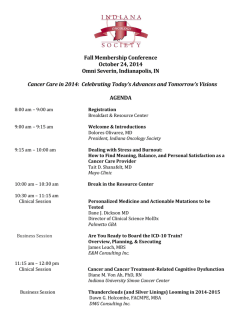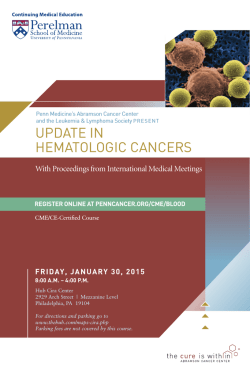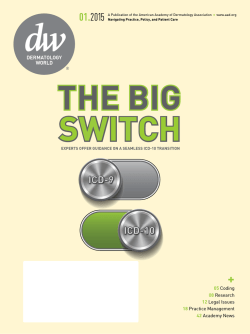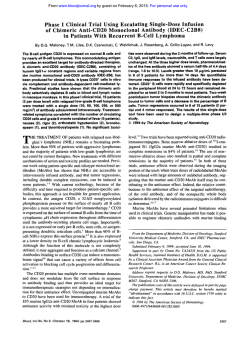
The PENTRA®Body Company
The PENTRA®Body Company January 2015 1 Agenda Summary Introduction PENTRA®Body Platform Dermatology Oncology January 2015 2 Summary Delenex at a Glance • Delenex was founded in 2009 as a spin-off from the ESBATech-Alcon/ Novartis acquisition • Delenex has a unique, proprietary and validated platform to generate PENTRA®Bodies which - are highly variable in CDR sequences targeting different epitopes - are highly stable and soluble - have excellent affinity/potency in the low picomolar to high femtomolar range • Delenex is a clinical stage company - DLX105 (anti-TNFα) in phase 1/2 by Delenex in psoriasis and Behçet disease • Our pipeline focuses on dermatology and oncology • Current main investors: BioMedInvest, HBM Partners, Novo Ventures, SV Life Sciences, VI Partners January 2015 3 Agenda Summary Introduction to Delenex PENTRA®Body Platform Dermatology Oncology January 2015 4 Introduction Corporate Background • Founded as spin-off from the ESBATech-Alcon acquisition in 2009 - ESBATech is now part of Novartis following the acquisition of Alcon in 2010 • Based in Schlieren (Zurich), Switzerland • Key investors: - BioMedInvest HBM Partners Novo Ventures SV Life Sciences VI Partners January 2015 5 Introduction The PENTRA®Body Platform • Proprietary technology platform for the development of locally and systemically administered antibody fragment therapeutics • PENTRA®Bodies are highly stable, humanized antibody fragments that are small in size, very potent, convenient to manufacture, easy to convert into other antibody formats and carry excellent tissue penetration characteristics • Ideal drug format for development in: - Dermatology (primary focus) - Oncology - Inflammation • Allows the development of treatments that would allow patients to stay off costly systemic antibody therapies for prolonged periods January 2015 6 Introduction The Platform: Key Properties and Applications PENTRA®Body Properties • Highly potent • Excellent antigen recognition and specificity • Small (excellent tissue penetration, short t1/2) • GMP production at low COGS • Clinical study in dermatology established proof-ofprinciple • Safe and well tolerated • Allow expansion of therapeutic areas and number of eligible patients • In many aspects superior to other, small (non-) antibody scaffolds Routes of Administration Topical/local • • • • Dermatology Oncology Ophthalmology Respiratory Systemic • • • • Flaring diseases Oncology Intoxication Infectious diseases Enteral • January 2015 Gastrointestinal 7 Introduction Applications: Focus on Dermatology and Oncology Cardiovascular Treatment of acute conditions such as reperfusion injury where rapid onset of action, good distribution, fast clearance of drug are beneficial CNS Intranasal or IV applications (with BBB-crossing), distribution in brain tissue Dermatology1 Topical application and penetration into skin tissue Gastrointestinal diseases Topical, rectal or oral administration with penetration into mucosal tissue Infections Conjugated with a pay-load, immediate recognition and elimination of the pathogen; rapid neutralization of toxins Inflammation Treatment of flares in immunological disorder such as gout by rapid onset of action, good distribution, fast clearance of drug Oncology1 Conjugated with pay-load, rapid and targeted distribution in tumor mass or facilitated access to hidden (micro)metastases Ophthalmology2 Topical application (eye drops) or injection into the eye Pain Rapid pain relief with a fast acting, local antibody fragment drug Respiratory diseases Inhalation and distribution in entire lung tissue Rheumatology Local injection with subsequent distribution in joint/tissue in osteoarthritis, rheumatoid arthritis, etc. 1 Areas 2 Rights of Delenex’ focus to ophthalmology indications owned by Novartis, through ESBATech/Alcon acquisition in 2009 January 2015 8 Introduction Expanding the Treatment Options in Dermatology • Focus on topical, local and short systemic administration of therapeutic antibodies addressing unmet needs in dermatology Expanding access to biologics to a much wider range of patients by non-systemic application Overcoming limitations of long-acting biologics by predominantly local/topical treatments Prolongation of periods with non-systemic therapy resulting in cost-efficient treatment options • Rich proprietary pipeline against validated molecular targets for all major indications • Phase 2 clinical study with DLX105 (anti-TNFα) in psoriasis has already provided proof-of-principle for topical administration of PENTRA®Bodies in dermatology January 2015 9 Introduction Products and Platform for Oncology/Inflammation • Focus on (short) systemic/local administration in selected tumors and inflammatory conditions • Targeting diseases with high medical need • Rich proprietary pipeline against validated molecular targets • Overcoming limitations of long-acting and larger biologics January 2015 10 Introduction Product Pipeline Product (Target) Indication DLX105 (TNFα) Psoriasis (intradermal) Psoriasis (topical) Hidradenitis suppurativa Ophthalmology¹ DLX2751 (TNFα) Psoriasis (topical) Hidradenitis suppurativa DLX2323/DLX2681 (IL-1β) Acne Acute gout DLX2882/3003 (IL-17A) Psoriasis DLX1008 (VEGF-A) Kaposi Sarcoma, Rosacea Oncology (glioblastoma) Ophthalmology* DLX2201 (IL-12/23) Lead Preclinic 1b/2a 2 completed completed ESBA105 ESBA1008/RTH258 Psoriasis, Inflammatory Bowel Disease * Rights to ophthalmology indications owned by Novartis, through ESBATech/Alcon acquisition in 2009 January 2015 11 Agenda Summary Introduction PENTRA®Body Platform Dermatology Oncology January 2015 12 PENTRA®Body Platform Modular Platform Bispecific PENTRA®Bodies PENTRA® PENTRA®ADC gr gr Toxin, cytokine, radionuclide Other… IgG & Fab based on PENTRA® VL VL VH CH1 CL CL CH1 VH VH VL CH1 CL S-S 1.-3. generation CAR January 2015 13 PENTRA®Body Platform Unique Characteristics • Low picomolar neutralizing potency • Anti-IL-1β PENTRA®Body with IC50 of 600 fM best-in-class • Rapid identification of potent development candidate (6 mo) no affinity maturation 2400 Inhibition of IL1β induced IL6 release 2000 rhIL-1RA 2800 1600 1200 Canakinu mab 800 DLX2323 400 0 0.1 10 1000 100000 Antibody, pM • Readily penetrates into skin and other surfaces In vitro model of skin: • Three times higher volume of distribution (Vdss = 12-16 liters) compared to IgGs Tailored for specific local and systemic applications January 2015 Distribution of labelled DLX105 around epidermal cells DLX105 Keratin 14 PENTRA®Body Platform Differentiation PENTRA®Bodies Standard mAb Other Antibody Fragments/Scaffolds 25 kDa 150 kDa < 20 kDa ~1 day ~3 weeks ~ minutes to hours high very low likely high Potency pM pM nM Affinity maturation no no required Molecular weight Pharmacokinetics Plasma half-life Tissue penetration Pharmacodynamics January 2015 15 PENTRA®Body Platform Humanized, Highly Stable and Modular • Sequence of human origin • 93% identical / 96% similar to closest human germline genes VL VH • Highly stable (Tm of up to 92°C) • Protease resistant • Highly soluble (up to at least 90 mg/ml) • Modular system allows rapid switching of format: scFv, Fab, IgG, bispecifics January 2015 16 PENTRA®Body Platform High Solubility and Stability of PENTRA®Bodies • Optimizing the hydrophilicity increases solubility • Optimizing the VL-VH interface increases stability January 2015 VL blue VH green 17 PENTRA®Body Platform Homogenous and Monomeric • Convenient, reliable expression in E.coli (GMP-validated) • Well scalable • Monomeric, homogeneous No impurities after DSP Monomeric in size-exclusion Single peak in mass-spec SDS-Page January 2015 18 PENTRA®Body Platform Effective Tissue Penetration (Cartilage) DLX105 Surface Cartilage tissue Four hours of diffusion of FITC-labeled DLX105 (26 kDa) 200 μm or infliximab IgG (145 kDa) into ex vivo bovine cartilage at physiological pH Infliximab Surface X Cartilage tissue 200 μm January 2015 19 PENTRA®Body Platform Rapid Grafting of CDRs from Various Sources VL VH + PENTRA® scaffold = CH2 CH2 CH3 CH3 Potent binding loops (CDRs) from novel or existing antibody VL VH PENTRA®Body The PENTRA® scaffold: flexible to design novel single-chain antibodies with CDRs from known IgG, synthetic libraries, public sequences or other sources January 2015 20 PENTRA®Body Platform Platform Delivers Highest Potency in Short Time • Recent screenings yielded monovalent, 25 kDa small PENTRA®Bodies with very high potency in very short time, i.e., within 6-10 months: IL-1β: antibodies with IC50 of ≤ 0.6 - 3 pM obtained within 10 months TNFα: IC50 of 20 - 30 pM within 8 months IL-17A: IC50 of ≤ 5 pM within 6 months • The timeline is rather dependent on the availability and robustness of a specific cell-based assay required for screening • Many, very different, highly potent PENTRA®Bodies against a chosen target are obtained offering choices re. epitope-specificity January 2015 21 PENTRA®Body Platform Modular Platform Bispecific PENTRA®Bodies PENTRA® PENTRA®ADC gr gr Toxin, cytokine, radionuclide Other… IgG & Fab based on PENTRA® VL VL VH CH1 CL CL CH1 VH VH VL CH1 CL S-S 1.-3. generation CAR January 2015 22 PENTRA®Body Platform Antibody Drug Conjugates (ADCs) • Trend to novel, smaller ADC formats with enhanced tumor penetration, e.g.: - ADCs based on DARPins (Molecular Partners/Roche) - ADCs based on nanobodies (Ablynx/Bayer) • Coming: ADCs based on PENTRA®Bodies - Tunable potency/affinity Small size for superior tumor penetration Highly stable Bivalent PENTRA®Bodies feasible, if receptor cross-linking is required for intracellular toxin delivery - Cloning of anti-cancer target PENTRA®Bodies started January 2015 23 PENTRA®Body Platform ADC Formats Bispecific PENTRA®ADC gr scFv PENTRA®ADC PENTRA® Toxin, cytokine, radionuclide gr IgG & Fab based PENTRA®ADC = drug, toxin enzyme, cytokine or radioisotope VL VL VH CH1 CL CL CH1 VH VH VL CH1 CL S-S January 2015 24 PENTRA®Body Platform Key Asset: Delenex Site Specific Functionalization VL VH HS SH ScFv functionalization enjoys granted US patent, with Delenex as exclusive licensee for all fields outside ophthalmology strongly supports ADC development January 2015 25 PENTRA®Body Platform ADC: Summary • ADC is an attractive area within oncology with two recent market approvals, and pharma/large biotech companies filling their pipeline accordingly • Delenex PENTRA®Bodies are well-suited for ADC development because of inherent favorable characteristics • Site-specific functionalization of scFv antibodies recently received US patent grant with Delenex as exclusive licensee • Delenex has started cloning anti-cancer target PENTRA®Bodies for ADC purposes January 2015 26 PENTRA®Body Platform Modular Platform Bispecific PENTRA®Bodies PENTRA® PENTRA®ADC gr gr Toxin, cytokine, radionuclide Other… IgG & Fab based on PENTRA® VL VL VH CH1 CL CL CH1 VH VH VL CH1 CL S-S 1.-3. generation CAR January 2015 27 PENTRA®Body Platform Bispecific Antibodies • Allow blockade of multiple targets or multiple sites • Alternative for combinational therapy of mAbs Development and approval of only one bispecific antibody compared to two individual antibodies • Small bispecific antibodies More rapid distribution and tissue penetration due to lower molecular mass (~50 kDa) has several advantages especially in dermatology, oncology, inflammation → High performing PENTRA®Bodies (potency & stability) are an ideal starting point for construction of small bispecific antibodies Byrne, H. et al. A tale of two specificities: bispecific antibodies for therapeutic and diagnostic applications (2013) Trends Biotechnol. 31(11):621-32 Kontermann, R. Dual targeting strategies with bispecific antibodies (2012) mABs 4(2):182-197 January 2015 28 PENTRA®Body Platform Bispecific Antibodies: Formats Diabodies (DB) scDB tandem scFvs Simple & small Well known1,2,3 1 Robinson et al. Targeting ErbB2 and ErbB3 with a bispecific single-chain Fv enhances targeting selectivity and induces a therapeutic effect in vitro (2008) Br J Cancer 99:1415-1425 2 Hudson and Kortt. High avidity scFv multimers; diabodies and triabodies (1999) J Immunol Methods 10;231(12):177-89 3 Kipriyanov. Generation of bispecific and tandem diabodies (2009) Methods Mol Biol. 562:177-93 January 2015 29 PENTRA®Body Platform Bispecifics: Potency Cell assays with human fibroblasts (IL-1β) and NK92 cells (IL-12) BiPENTRA®Body IC50 / IC50 (parent)* IC50 / IC50 (parent)* DLX2959 2.3 2.2 DLX2960 1.7 1.1 DLX2961 1.4 1.5 DLX2962 1.8 1.5 DLX2963 1.2 4.4 DLX2964 2.8 1.3 * Normalization to potency of parent scFv → All constructs basically preserve potency of the parental scFvs. It remains to be seen whether the partially reduced potency in one arm of DLX2963 is a general phenomenon January 2015 30 PENTRA®Body Platform Anti-IL-17A x Anti-TNFα January 2015 31 PENTRA®Body Platform Anti-IL-17A x Anti-TNFα Biologics • ABT-122 (AbbVie) Phase II study ongoing for RA 190-200 kDa • COVA322 (Covagen) Entered phase Ib/IIa in 04/2014 160-170 kDa • Eli Lilly Pre-clinical IgG-scFv, ~180 kDa • DLX2907/DLX2909 (Delenex) Pre-clinical 52 kDa IC50: 5/33 pM (DLX2907/2909) for IL-17A and 20-30 pM for TNFa, i.e., the potencies of the original monovalent PENTRA®Bodies are fully preserved January 2015 32 PENTRA®Body Platform Bispecifics: Summary/Outlook • Bispecific PENTRA®Bodies demonstrate - lab scale expression & purification (non-optimized) - simultaneous binding to both antigens - about the same potency as the parent scFv (which is not trivial) • Various bispecific PENTRA®Bodies are currently being cloned and tested • E.g., Delenex’ anti-IL-17A x anti-TNFa bispecific PENTRA®Bodies DLX2907 /DLX2909 show the same high potency as the parental monospecific scFv modules, i.e., about 5/33 pM and 20-30 pM, resp., neutralizing potency IC50 • Next - animal model(s) - nomination of targets in oncology January 2015 33 Agenda Summary Introduction PENTRA®Body Platform Dermatology Oncology January 2015 34 Dermatology - DLX105 as a Proof of Concept Antibody DLX105: the Anti-TNFa Frontrunner Drug • DLX105 is the clinical frontrunner with an IC50 similar to infliximab and patent protection until 2028 • DLX2751 is a 10x more potent follow on drug in preclinical stage with patent protection until 2035 DLX105 tolerability and exploratory efficacy profile was tested in 3 clinical trials: Psoriasis trial 1 - intradermal Psoriasis trial 2 - topical • Intradermal injection of • Topical application of DLX105 DLX105 • Placebo-controlled, • Placebo-controlled, randomized intra-individual randomized parallel group trial with a total of 20 patients trial with 59 patients January 2015 Behçet disease - systemic • Intravenous administration of DLX105 to healthy and Behçet disease subjects • To explore PK and healing of mucosal and skin signs after a single i.v. dose of DLX105 35 Dermatology - DLX105 as a Proof of Concept Antibody DLX105 Delivered Positive Clinical Results Psoriasis trial 1 - intradermal Psoriasis trial 2 - topical Behçet disease - systemic • Intradermal injection • Topical application of • Intravenous induced healing of DLX105 induced cytokine administration of DLX105 psoriatic plaques mRNA improvements in has a profound and fast the skin, but no clinical effect on mucosal and • In the range of what improvement over skin eruptions over 2 infliximab or ustekinumab placebo weeks delivered within 2 weeks (30 to 40% PASI improvement over baseline) Erythemata nodosa in a Behçet patient Clinical improvement of psoriasis after intradermal DLX105 January 2015 X-fold skin mRNA changes after topical DLX105 Substantial improvement within 2 weeks after a single dose of DLX105 i.v. 36 Dermatology Assets Excellent Pipeline: Addressing Big Indications Priority Product (Target) Indication (route of administration) Core projects DLX105 (anti-TNFα) Hidradenitis suppurativa (s.c./topical/patch device), Behçet disease DLX2323/DLX2681 (anti-IL-1β) Acne (s.c./topical) DLX2882/3003 (anti-IL-17A) Psoriasis (topical) Anti-IL-4/13 bispecific Atopic dermatitis (s.c./topical) Anti-IL-17A/TNFα bispecific Psoriasis (s.c./topical) DLX1008 (anti-VEGF-A) Kaposi sarcoma, rosacea, keloid, portwine stain (intralesional, topical) DLX2201 (anti-IL-12/23) Psoriasis (topical) DLX2751 (anti-TNFα) Psoriasis, pyoderma gangraenosum, (s.c./topical) Upside projects Delenex explores devices to increase dermal exposure, in particular for hidradenitis suppurativa, and needle-free self injectors in particular for children and adolescents with atopic dermatitis January 2015 37 Dermatology - Hidradenitis Suppurativa (HS) - DLX105 (anti-TNFα) HS: a High Unmet Medical Need Condition • Chronic inflammatory disease that affects apocrine-glandbearing body areas such as the axilla or the ano-genital region • No effective treatment is available, medical need is high • Hurley Stages I and II most often require oral antibiotic therapy for up to 12 weeks, stage III requires surgery • A phase 3 study with adalimumab 40 mg weekly achieved a significantly greater response versus placebo at week 12 (41.8% versus 26%, p = 0.003) where response was defined as an at least 50% improvement over baseline of abscesses and inflammatory nodules (44th European Society for Dermatological Research (ESDR) Meeting in Copenhagen, Denmark, 2014) • DLX105 highly likely to be superior due to excellent tissue distribution January 2015 38 Dermatology - Psoriasis – DLX2882/3003 (anti-IL-17A) Psoriasis: IL-17A Most Promising New Target • Systemic use of anti-IL-17A mAbs has demonstrated extraordinary efficacy in phase 3 trials in psoriasis • IL-17A is produced predominantly by dermal T cells, but has its major activity on epidermal keratinocytes • Topical DLX2882/3003 (IC50 < 10 pM) is likely to inhibit IL-17A bioactivity in the epidermis N Engl J Med 2014;371:326-38. January 2015 39 Dermatology - Acne - DLX2323 (anti-IL-1β) Acne: Femtomolar Antibody To IL-1β biological activity • Prevalence for severe acne is 1% • Very little innovation in acne over decades • IL-1β has been validated as the inflammatory marker in acne • PENTRA®Bodies targeting IL-1β are best in class with femtomolar neutralizing activity January 2015 Antibody IC50 (pM) Ilaris® 37.5 ± 11.0 DLX2323 3.0 ± 1.05 DLX2681 0.6 ± 0.42 Patient with PAPAlike syndrome (pyogenic sterile arthritis, pyoderma gangrenosum and acne) before (left) and after 3 injections of canakinumab (Day 90); from JAMA Dermatol 2013; 149: 209 Mouse P.acnesinduced ear swelling is inhibited by IL-1β but not by TNFα inhibition (Kistowska et al., JID 2014, 134:677) 40 Dermatology Summary and Outlook • Delenex has a unique, proprietary and validated platform to generate PENTRA®Bodies which - are highly variable in CDR sequences targeting different epitopes are highly stable and soluble have excellent affinity/potency in the low picomolar to high femtomolar range • Delenex is a clinical stage company - DLX105 (anti-TNFα) in phase 1/2 by Delenex in psoriasis and Behçet disease • These PENTRA®Bodies are particularly suited for conditions where - a flaring condition requires quick systemic medical intervention a chronic condition requires long topical/local exposure • Delenex is currently focusing on the further development of - DLX105 for hidradenitis suppurativa and DLX2323 for acne anti-IL-17A for psoriasis and anti-IL-4/13 for atopic dermatitis January 2015 41 Agenda Summary Introduction PENTRA®Body Platform Dermatology Oncology January 2015 42 Oncology Advancing the Standard of Care (1/2) Why PENTRA®Bodies in oncology? • 25 kDa PENTRA®Bodies efficiently penetrate and distribute into tissues • The PENTRA®Body technology offers a tool box with: - a wide range of potencies (down to femtomolar IC50) - high antibody sequence variability, enabling choice of epitope - diverse formats attractive for cancer immunotherapy (multispecific, ADC, immunoconjugates) • PENTRA®Bodies allow flexible and controllable patient exposure to the therapy • PENTRA®Bodies are clinically validated January 2015 43 Oncology Advancing the Standard of Care (2/2) Inhibiting angiogenesis with 27 pM DLX1008 • The monovalent scFv DLX1008 displays very high affinities to human (27 pM) and mouse VEGF-A (21 pM) facilitating more rapid drug development • GMP production of DLX1008 is initiated, the Master Cell Bank is available • Delenex is developing DLX1008 for oncology, with a focus on Kaposi's sarcoma and glioblastoma Expanding our oncology portfolio • Targeting cytokine and immune check-points with bispecific PENTRA®Bodies • Overcome drug resistance with bispecific PENTRA®Bodies • Cell-based therapy with PENTRA®Body guided subsets of T cells January 2015 44 Oncology Summary and Outlook • Our proprietary and clinically validated PENTRA®Bodies offer novel therapy options in oncology • DLX1008, a highly potent 25 kDa anti-VEGF-A PENTRA®Body, is in pre-clinical oncology studies • Master Cell Bank for GMP production of DLX1008 is available • We plan to expand our oncology pipeline with several innovative programs applying DLX1008, new bispecific antibody fusions as well as T cell-based approaches, profiting from the clearly differentiating characteristics of our PENTRA®Bodies January 2015 45
© Copyright 2025








